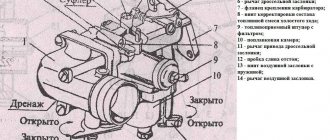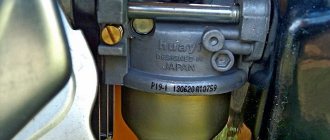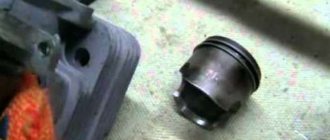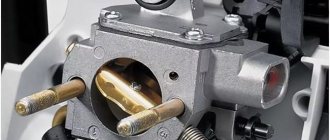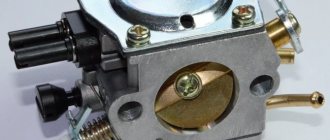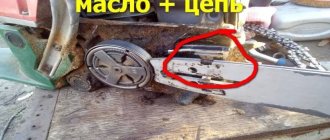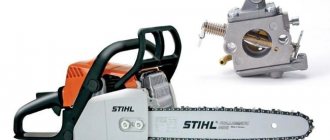Chainsaw engine malfunction
Signs of a chainsaw engine malfunction:
- the engine does not start - the engine runs unstably - the engine starts, but very often stalls - the engine quickly overheats - the engine runs normally at idle, but “chokes” under load - the engine smokes heavily, power drops
In certain situations, it is better to seek help from professionals and take your saw to an authorized service center. But you can deal with some problems yourself.
In general, in order to eliminate the cause itself, you must first correctly identify it, otherwise the entire repair will be tantamount to shooting at sparrows from a cannon, and perhaps even shooting at “fictional” sparrows, since there may not be any breakdown.
If you are trying to start a chainsaw, but it does not start, and at the same time does not make any strange sounds that are not typical for it (knocking, grinding), then you are simply starting it incorrectly (if you pull the chainsaw on the choke for a long time, the internal combustion engine is filled with fuel, and then start its difficult).
How to start a cold engine correctly? 1. Set the lever or switch to the “flap closed” position. 2. If the model is equipped with a fuel priming pump, pump the fuel mixture into the carburetor. 3. Pull the starter handle until resistance appears, then vigorously pull in amplitude, moving your hand to the side (2-3 times). No need to try to “rip” the starter cord out of the chainsaw! The saw should start and then stall. 4. If the engine does not start, move the lever to the half-throttle position or to the working position, and try to start the chainsaw in this mode. Please note: Some models have a push-button ignition switch, make sure it is turned on.
What to do if the engine still doesn’t start? First, unscrew and inspect the spark plug. It happens that when starting a chainsaw in cold weather, the combustion chamber is accidentally filled with fuel mixture. In this case, you should also unscrew the spark plug, dry the combustion chamber by idling, clean the spark plug, and try to start the saw again.
How to check for spark on a spark plug? Place the unscrewed spark plug connected to the high-voltage wire on the cylinder and pull the starter. Be careful! You cannot touch the candle with your hands during this procedure! If you see a blue spark, the spark plug is OK. We screw the spark plug into place and try to start the saw again. If we fail again, we’ll check the connection of the high-voltage wire to the spark plugs, the coil and the ignition system.
Based on the state of the spark plug, you can understand what happened to the saw:
- Dry candle. Apparently, the fuel mixture will not get into the cylinder. The problem is not in the spark plug, so we screw the spark plug back in. And we check the fuel supply system.
- A wet, heavily fuel-stained spark plug. The reason for excess fuel is hidden either in violation of the model factory rules, or in incorrect carburetor adjustment.
- The candle was covered with black soot. This may indicate the use of low-quality oil (so use only original oil for your saw), an incorrectly adjusted carburetor, or an incorrectly prepared fuel mixture. The spark plug needs to be washed, thoroughly cleaned of carbon deposits with an awl or a needle, the electrodes should be wiped with sandpaper and screwed into place.
When checking the spark plug, pay attention to the gap between the electrodes (it should be 0.5 - 0.65 mm). A worn gasket must be replaced.
When adjustment is needed
As already mentioned, the new chainsaw already has standard fuel supply settings. But for proper break-in, it is recommended to limit the maximum engine speed, and this is done using adjusting screws located on the carburetor body. Also, after running in, you will need to again make more precise adjustments to the supply of the combustible mixture.
In addition, the carburetor will have to be adjusted in the following cases:
- due to strong vibration, the factory settings were lost;
- The internal combustion engine does not start well and stalls immediately;
- The internal combustion engine starts, but the speed does not develop, and it stalls;
- the piston group is worn out - in this case, adjusting the chainsaw carburetor is possible as a temporary measure;
- the engine does not operate at idle speed;
- increased gasoline consumption, which causes the unit to produce a lot of smoke, contaminate the muffler and spark plug with soot, and reduce engine power.
Checking and adjusting the carburetor
In service centers, carburetor adjustment is carried out using special equipment. For each saw, the angles of rotation of the adjusting screws are different (they are indicated in the operating instructions). The need to adjust the carburetor does not arise very often, especially if the saw was purchased from a trusted seller. All of our Husqvarna saws are sent to a service center before being sold, where specialists adjust the speed control.
However, failure to secure the adjusting screws sometimes occurs.
Reasons for failure to adjust the chainsaw carburetor:
- Severe wear on the engine (pistons). In this case, it is necessary to take greater care of repairing the engine, but adjusting the carburetor can improve the functionality of the saw for a certain amount of time.
- Blockage in the carburetor due to damage to the air filter, use of poor quality gasoline and the formation of scale. In such a situation, in addition to adjusting the carburetor, you will also need to flush it.
- Severe vibration of the saw or damage to the protective cover. This happens extremely rarely, but there are still cases.
Signs that indicate the need to adjust the chainsaw carburetor:
- The engine either does not start, or starts and immediately stalls. This occurs due to the use of a poor fuel mixture.
- Significant increase in fuel consumption and emissions. An increase in the amount of exhaust gases indicates that the fuel is not completely burned. The reason for this may be fuel oversaturation.
The carburetor adjustment scheme differs for different models of chainsaws and is described in the operating instructions. However, the general principle remains the same: it is necessary to change the quantity and quality of the fuel mixture supplied to the engine cylinder.
Three screws will help us adjust the carburetor:
- “L” – low, for setting low speeds
- “H” – high, for setting the upper speed
- “T” (“LA”, “S”) – for adjusting the idle speed (models that have only one screw have the “T” screw)
When adjusting the carburetor of a chainsaw, the following rules should be observed:
- Make sure the saw chain is pointing away from you
- Place the saw on a stable, level surface; the cutting part should not touch any objects.
To sum it up...
Definitely, every item we buy has its own expiration date and sooner or later it breaks, and it becomes a shame when the degree of its breakdown is so great that it cannot be repaired. But you must admit that quite often we simply treat technology negligently, and when it stops working, then we try to find ways to fix the breakdown, turning to a huge number of services.
Randomly accelerating “INFORMAL CHAINSAW” Specific reason!
The quality of the cut and the overall efficiency of the chainsaw are influenced by many factors, the main one of which is the speed of its engine. Their intensity or absence can indicate the most typical malfunctions of garden tools, including damage to the engine CPG, breakdown or need to adjust the carburetor, as well as wear and tear on the ignition system elements.
Final carburetor adjustment
First, warm up the engine for 5-10 minutes (not at high speeds).
Adjusting idle speed
Now, by turning the idle speed screw (T, LA, S) counterclockwise, adjust the minimum number of revolutions at which the engine is stable. The chain should not move. If the engine stops idling, turn the idle speed screw clockwise accordingly. If the chain moves, turn the screw counterclockwise.
To finalize the chainsaw carburetor adjustment, we check the engine for acceleration and maximum speed.
Checking the acceleration
Smoothly press the accelerator and watch how quickly the engine picks up speed from idle to maximum power. If the engine revs slowly, it may be necessary to loosen the L (low speed) screw by turning it slightly counterclockwise (no more than 1/8 turn).
Setting the maximum speed
As mentioned earlier, the maximum speed is adjusted using screw H, the speed increases when turned clockwise, and decreases when turned counterclockwise.
The highest rotation speed of gasoline chain saw engines is between 11,500 and 15,000 rpm, depending on the model. Higher speed is dangerous for the engine, which will prevent it from starting. The maximum speed can be determined by interruptions in the ignition. If any appear, turn screw H counterclockwise.
Check the chainsaw again at idle speed
Once we have adjusted the acceleration and maximum speed, we again check the engine at idle speed. We will know that we have adjusted the carburetor correctly if:
- The chain does not move at idle
- The engine revs up
- The sound of a running engine is reminiscent of a four-stroke internal combustion engine.
If at least one of these conditions is not met, the adjustment should be repeated (excluding the basic stage).
Setting up the fuel system
Qualified carburetor adjustment allows you to bring the power unit to a combination of maximum traction parameters and economical fuel consumption.
The success of the work is facilitated by preliminary cleaning of the air intake filter, warming up the engine to operating temperature, and performing adjustments in the sequence specified in the instructions.
The result of correct carburetor adjustment is:
- rapid acceleration without the “failure” characteristic of a lean mixture when accelerating sharply;
- absence of increased smoke from the muffler;
- stable idle speed.
Checking the muffler
Do not underestimate the breakdown of this chainsaw assembly. If the muffler becomes clogged, the saw will lose power and, of course, will not start. If the muffler is dismountable, then we disassemble it, inspect it and remove all carbon deposits. In some models, the muffler will have to be unscrewed; after washing, the non-removable muffler should be dried with a hairdryer.
Please note: carbon deposits contain carcinogens that are dangerous to human health; dry cleaning is unacceptable as it can lead to inhalation of these harmful substances.
When we remove the muffler, we plug the engine exhaust hole with a clean rag. The reasons why the muffler may become clogged are:
- Using the wrong fuel mixture (too much oil)
- Using the wrong oil (oil not for two-stroke engines or poor quality oil)
Summing up
When the first signs of improper operation of the chainsaw appear, it is worth carrying out a full diagnosis. To avoid damage to the saw as a result of improper maintenance, it is better to entrust the work of identifying and eliminating engine malfunctions to professionals. And most importantly, you should not use a chainsaw with minor defects, as this will lead to even bigger problems.
READ Replacing the Oil Pump on a Partner 350 Chainsaw
the chainsaw starts up poorly and stalls , there can be no talk about the performance of the simplest sawing work. Not only budget-class instruments are susceptible to spontaneous failures, but also quite prestigious models from leading manufacturers.
Malfunction of the chain lubrication system in the chainsaw
What types of breakdowns occur in the chain lubrication system:
- No or low oil supply
- Oil leakage
In the first case, we first inspect the channels through which oil is supplied to the tire and clean them. Their clogging is a fairly common occurrence.
If there is significant oil leakage (small oil leakage is normal for all gasoline saws), you should check the tightness of the tubes and fittings of the oil pump. Tubes may fall off and even crack. Violation of the tightness of the tubes is eliminated by replacing them or sealing them with sealing material.
As for oil pumps, they may have different designs for different models of chainsaws, and the drive is also carried out differently (as a rule, the drive is carried out by a drive sprocket or a special gear on the crankshaft). If there is a problem with the oil pump, then most often you will not have to completely replace this entire unit; it will be enough to replace its moving part (plunger), which most often fails due to the ingress of large amounts of dirt and sawdust.
The most serious damage is a crack in the oil pump housing. In this case, you will have to completely replace it.
Conclusion
When the first signs of loss of power (reduction in speed) of the KS 180 chain saw are detected, under no circumstances should you continue to operate it and you should immediately contact a specialist or carry out diagnostics and repair the fault yourself. There are not many reasons for losing power, and you can even cope with them even without certain skills. The main thing is to calmly analyze the behavior of the saw and find out the reasons why it stopped pulling (the speed has dropped), and it is no longer easy to correct the malfunction.
Modernization does not stand still. And the old chainsaws, which in addition to being able to only cut wood, emitting a terrible roar and vibration that could be heard almost kilometers away, are long gone. Almost silent, thorough tools that are now a pleasure to hold in your hands have flooded the market, giving users a feeling of complete happiness and technical freedom.
But, unfortunately, no matter how technically and visually advanced the advanced technology is, its breakdowns are a fairly common occurrence, which manufacturers talk about only “by default.” Chainsaws are no exception to this, multifunctional working units that require enormous attention from the user in order to recognize the “catch” in time and stop the problem at the earliest stages.
The main of these nuances usually relate to the moment of launch, which should be taken with full responsibility. Let's look at the main processes that can occur with a chainsaw when the engine is turned on.
How to avoid premature breakdowns? Chainsaw maintenance tips
Your main assistant should be the instruction manual. If you have lost it, you can contact the dealer of the company whose chainsaw you use; they will provide you with instructions in electronic form.
So, before each time you turn on a gasoline chain saw, be sure to check that the chain is in good condition, whether its teeth are sharpened, and whether it is well tensioned (does not sag, but is not too tight, it can be pulled a little away from the blade).
You can sharpen the chain using a special machine or a file with a special template (depending on the tooth pitch of the chain, there are different templates).
Every time after use, the chainsaw must be cleaned: the chain, bar, air filter, housing, cooling fins, cracks and other grooves are cleaned of sawdust. After using the saw, turn the bar over so that it wears evenly, lubricate the sprocket (if there are grooves for lubrication in the front of the saw).
During long-term storage, be sure to drain the fuel and oil! The chain and the bus form an electrochemical pair, so they rust together and must be stored separately.
How to properly adjust the carburetor with your own hands?
After washing and completely cleaning the carburetor, it is assembled and adjustments begin. First of all, you should understand the purpose of the adjusting screws. The instructions will help with this, but some general points should be considered immediately. The most common designation for screws is:
- H - adjusts the state of the main jet, i.e. adjusts the maximum rotation speed of the motor shaft;
- L — adjusts the idle jets (responsible for the minimum shaft rotation speed);
- T - regulates engine idle speed. It can also be designated by the letters LA or S; on some carburetor models it is completely absent.
Turning screws H and L clockwise leans the fuel-air mixture, and counterclockwise turns it rich (the amount of gasoline increases). When screw T rotates, the shaft rotation speed at idle speed changes - clockwise it increases, and in the opposite direction it decreases.
Figure 2 – Carburetor adjustment mechanisms
Unstable operation of the chainsaw. Eliminating the cause.
Before you begin direct action, you should find and carefully study information about the position of the adjusting screws (the magnitude of the rotation angles when adjusting). This information is available in the instructions for the chainsaw. Then you need to prepare the workplace - lay the saw on a flat horizontal plane, pointing the chain in the direction opposite to you. Disconnect all covers, remove foam and air filter. At this point, the preparatory operations are considered completed, and the main part of the work can begin.
- Smoothly tighten screws H and L clockwise until they stop. Be careful not to break the screws - this will cause complete loss of the carburetor.
- Unscrew both screws one and a half turns.
- Run the engine for 10 minutes and warm it up. This is a necessary point, since it will not be possible to adjust the carburetor correctly on a cold engine.
- By turning screws H and L, alternately adjust the rotation of the shaft at maximum and minimum speed.
- By adjusting the position of screw T (or it may have a different designation), the idle speed of the chainsaw is adjusted. It is necessary to achieve smooth and stable engine operation. It is important to monitor whether the chain moves at idle or not. If it moves, turn the screw counterclockwise a little more.
Important! It is better not for an inexperienced person to adjust screw H. If it is not configured correctly, a lean air-fuel mixture will be supplied to the cylinder combustion chamber at maximum speed. This will lead to accelerated wear of the piston group.
You can check the engine's operation visually and by ear. A mixture that is too rich causes thick smoke to come out of the exhaust. When feeding a lean mixture, a whistle is heard while the saw is running. Excessively economical mode is harmful - if screw L is set to “lean” fuel, problems will arise with starting the engine. When setting screw H to a lean mixture, the saw will noticeably lose power. The correct setting can be determined by the following criteria:
- at idle, the engine does not stall, and the chain does not move;
- there is no excessive smoke from the exhaust pipe when the engine is running;
- the engine demonstrates good throttle response (quickly picks up speed when you press the accelerator).
A detailed description of the settings is available in the instructions that come with the tool in the package. It should be carefully studied, since there may be some features or specific requirements established by the manufacturer and relating only to this model of saw. If all requirements are met exactly, the operation of the chainsaw will be restored to its original state.
The chainsaw stalls. Main reasons
In this article we will not discuss in detail the reasons for cases in which the saw does not start at all. The list of faults for such a problem is too extensive: from factory defects to problems in the ignition system. This article will focus on a specific flaw in the operation of the saw: the device stalls immediately as soon as it is started, or for some time during operation.
Let's look at typical faults:
Low quality fuel mixture
Gasoline must be poured into equipment in strict accordance with the manufacturer’s recommendations. Unfortunately, many people ignore this advice and use what they “have at hand.” This solution leads to a decrease in thrust, detonation and the appearance of soot. As a result, the quality of operation of the internal combustion engine decreases, the saw ceases to cope with its tasks, and stalls under high load. The fuel must be completely exhausted; if the period of time between working with the saw is quite long, it must be drained. It is not recommended to use low-octane gasoline. But checking the quality of the gasoline-oil mixture is rather a recommendation for preventing breakdowns. If the main cause of the problems is that a low-quality mixture has already been used, replacing gasoline alone will not do.
The problem with the candles
Checking the performance of the spark plug should begin with a visual inspection. The candle must be dry and clean. If the saw stalls, there is a possibility that the spark plug has been flooded. This happens with incorrect attempts at a cold start, especially among inexperienced saw owners. In this case, you need to try either installing a new spark plug or drying the old one.
A spark plug covered with soot can signal both the quality of the mixture and problems with the carburetor: the reason lies either in fuel overflow or in the oil supply to gasoline.
Another breakdown may be related to the ignition unit: when there is no spark. As a rule, in this case the spark plug itself remains clean and there is contact between it and the high-voltage wire. The ignition unit is usually not repaired, but replaced completely.
The chainsaw stalls under load due to the carburetor
Almost half of all problems that cause the saw to stall when you press the gas are related to the carburetor:
- The jets and injectors are clogged . When using low-quality fuel, the fuel filter allows impurities in the gasoline to enter the carburetor. As a result, the elements of this design become clogged, which leads to a reduction in fuel supply. The saw loses power, and when the speed increases, it begins to stall. The issue is resolved by disassembling and washing the carburetor.
- The needle sticks out . If the accelerator pump needle becomes stuck due to physical wear or debris, the saw will also stall. True, not only at high speeds - at any time.
- Check valve needle problem . If the spark plug is damp, and you are confident that you start the saw without errors, the problem may lie in a loose fit of the check valve needle to the seat. This problem usually appears under load.
- The carburetor sucks in air . Does the saw not pick up speed or stalls under load? Perhaps the problem is just the carburetor gasket. Finding out this is problematic and will only be possible by reassembling the module. Therefore, before removing it, prepare gaskets and seals in order to replace them all.
Check the filters
If the saw does not receive enough air or fuel, it will naturally stall when trying to increase the speed or even just at idle. Checking for filter contamination is done purely visually. If there is a suspicion of problems with dirt, the filters need to be changed.
Replacement of hoses, seals, gaskets is necessary
Any plastic and rubber elements become unusable over time. If the saw works at idle, but when you try to increase the speed, it either does not pick up speed, or does so very weakly (or stalls), you need to check the hoses and seals for integrity. Problems with hoses are usually identified simply by inspection, but loss of seal seals can be determined in most cases only by supplying air under pressure.
A problem with the gaskets is usually detected immediately or a short time after the saw is repaired. If you or someone else recently disassembled the unit, after which the described problems arose for no apparent reason, you need to check the quality and correct installation of the gaskets.
Muffler clogged
Over time, the muffler can become clogged. This occurs as a result of using a fuel mixture with too much oil. Deposits that appear in the muffler interfere with the free flow of gases, resulting in reduced engine power. This malfunction can be determined by the gradual manifestation of the problem, as well as by carbon deposits on the muffler.
Malfunction of the cylinder-piston group
As a result of scuffing on the piston walls, the speed problem in question can occur. Usually, scuffs can be found on the muffler side. As a rule, this breakdown is solved by replacing the CPG, the cost of which can be comparable to the price of the saw itself.
The chainsaw itself is gaining momentum - how to solve the problem?
This malfunction most often indicates a violation of the operating mode of the fuel and other systems of the chainsaw. There is no single specific cause for this breakdown, since an arbitrary increase in the speed of a running motor can result in the formation of a defect in several different components at once.
The first thing the operator needs to do is inspect the fuel system components. Quite often, a chainsaw engine picks up speed on its own when the fuel supply settings in the standard carburetor are disrupted. In this case, you will need to remove the assembly, disassemble it and wash it with clean gasoline. After it dries, you need to install the carburetor back and make its settings.
Next you need to inspect the condition of the fuel filter. As a result of prolonged use of the chainsaw, it may become damaged. Because of this, the fuel will enter the cylinder unfiltered, with a large amount of impurities and small chips. This can damage the motor and cause it to seize. As a result, the chainsaw will randomly pick up speed immediately after starting its internal combustion engine.
The next step is for the operator to inspect the fuel pipes. They should sit in their seats and, most importantly, there should be no holes in their walls. If they appear, the fuel hose will need to be completely replaced.
Another reason for an arbitrary increase in speed is the jamming of the gas lever. If the operator frequently pressed it while wearing oil-stained gloves, grease particles could seep into the lever and stick to its surface. As a result, the lever itself will begin to stick to the walls of the housing, giving the command to the engine to gain speed. Disassembling and subsequent cleaning of the body and gas lever of the chainsaw will help solve this problem.
Why does a chainsaw stall when gas is supplied?
We recommend identifying the causes in the following order:
- Check the spark plug. If necessary: dry, clean off carbon deposits, check the gap.
- Check spark.
- Check the cleanliness of the filters.
- Inspect the fuel hoses and seals for damage causing air leaks.
- Replace the fuel mixture in strict accordance with the manufacturer's recommendations.
- Inspect the muffler for carbon deposits.
- Check the carburetor settings and clean if necessary.
- Check for scoring on the CPG.
Remember: the chainsaw must be operated in strict accordance with the manufacturer’s recommendations. Most problems that result in the chainsaw stalling when adding gas are associated with violations of the rules set out in the instructions.
What to do if the chainsaw is not idle?
Downtime problems are considered constant companions of chainsaws. There may be several preconditions that can lead to clogging during cranking and cranking at idle, the main ones being:
- Air and gas filters;
- Poor quality fuel mixture or improper preparation;
- Problems with the ignition module;
- A carburetor whose settings no longer correspond to the load on the saw;
- Engine components are deformed or rusty.
Follow these steps in sequence:
- Clean the fuel hose or replace it with a new one,
- They clean the air filter, which can become clogged with sawdust and dirt particles. Modern air filters are reusable; they can be washed with the addition of detergent, completely removing the saw from the body;
- Check for gasoline and motor oil, which may be of poor quality or simply unsuitable for use with this saw;
- Checking spark plugs and carburetor.
Correcting one or more possible problems will usually return the saw to its former strength.
Why does the chainsaw stall when you press the gas?
Hello! If you've landed on this page, it's likely that your chainsaw is stalling when you press the gas, and you want to know why this is happening and what to do about it. Well, I’ll try to help you with this problem by analyzing the most common causes of this misfortune, as well as methods for eliminating them.
To begin with, I’ll immediately write for novice users that many chainsaws require warming up the engine at idle for about one minute before use. Until the engine is warmed up, the saw may stall when gas is added.
Signs of characteristic failures
If the saw engine does not pick up speed and stalls, does not develop power and stalls under load, there is most likely a lack of fuel or incorrect carburetor adjustment.
The list of possible causes includes contamination of the fuel filter or air intake filter element, too rich or lean gasoline-air mixture.
Signs of the engine running on a rich mixture:
The chainsaw stalls when you press the gas - most likely the mixture is too lean.
There is little oil in the fuel mixture
First, let's look at the most unpleasant case. Why? Because before manipulating the filters, it is better to make sure that the oil and gasoline are mixed in the correct ratio.
Here, however, it is worth noting that if you have already started your saw many times (for example, ten times), but continues to start, and then stall again when the speed increases, then apparently everything is in order with the fuel. Otherwise, it would simply stop starting altogether.
But still, I recommend immediately dispelling the slightest doubt about the quality of the fuel as soon as your saw stalls when picking up speed for the first time. Because if the reason is fuel, then, as mentioned above, you can end up with expensive repairs. And so, everything can still work out. To dispel doubts is to drain the old fuel from the tank and fill it with freshly prepared fuel, in which oil and gasoline are mixed in the correct proportions.
It is better to look at the instructions for the saw for the correct ratio. If you have lost it, then look at the ratio on the oil package. Usually it is 1:50 or 1:40. If the oil used is “non-native” (well, for example, for Stihl chainsaws there will be little Stihl “native”), then I recommend using a proportion of 1:40, even if the oil package says 1:50.
For accurate dosage, I personally use a medical syringe and a measuring container in which one liter of gasoline can be clearly measured. I pour a liter of gasoline into a container, fill a syringe with 25 (at 1:40) or 20 (at 1:50) cubes of oil and add it to the gasoline.
After preparing a new mixture, we drain the previous mixture from the tank, which we are unsure of, and fill it with fresh, just prepared one.
Now that you have done everything to dispel any doubts about the quality of the fuel, let's move on to further actions.
As I wrote above, if there is a lack of oil, scuffing can form on the piston and cylinder walls - and they almost always do. If you are lucky and no scuffs have appeared, then with a new fuel mixture prepared in the correct ratio, the chainsaw should start working normally.
If scuffs appear, the saw may start and stall several more times, after which it will stop starting altogether. In this situation, I sympathize with you, since, most likely, now you will need to replace the piston group, which will be very expensive.
If the saw, as before, starts and stalls at high speeds, then we manipulate the filters.
avtoexperts.ru
The engine is the “heart” of a car, and like the human heart, interruptions sometimes occur in the functioning of this “organ”. We become aware of problems with the engine by reading the rpm. If the speed of the power unit begins to float , the engine gives us a signal that something is wrong with it. In our material today we will tell you what breakdowns are hinted at by jumping engine speeds, how to correctly diagnose and repair them.
The reason for the appearance of floating speed
The driver can find out that there is something wrong with the engine speed by looking at the tachometer. During normal operation of the power unit at idle, the needle of this device remains at the same level (usually within 750-800 rpm), and if the engine has problems, the needle either falls or rises (range from 500 to 1,500 rpm and higher). If the car does not have a tachometer, then the floating speed can be heard by ear: the rumble of the engine either increases or decreases. And also - by the increasing and decreasing vibrations penetrating into the car interior from the engine compartment.
As a rule, unstable engine speed occurs at idle. But even at intermediate engine speeds, dips or rises in the tachometer needle can be detected - this is typical for diesel engines. Let's consider these two cases separately to understand why these phenomena occur.
Speed jumps at idle
Floating idle speed most often occurs on injection engines. This is due to the peculiarity of regulating the operation of the idle system by the electronic engine control unit (ECU). The electronic “brains” of the car constantly read information about the idle speed, and if it is violated, they give a command to the sensors responsible for the correct functioning of the system to correct the situation. Idling may be disrupted due to excess air getting into the fuel system, and specifically into the engine cylinders. In this case, the mass air flow sensor signals the ECU that excess air has entered the combustion chamber. To equalize the amount of air and fuel that together form the air-fuel mixture, the “brains” command the injector valves to open and let more fuel into the cylinders. At this moment, the engine speed increases sharply. Then the ECU “realizes” that it has supplied too much fuel to the cylinder and limits its supply - at this moment the speed drops sharply.
The second reason for floating speed at idle is the failure of the idle speed controller (IAC).
It is an electric motor, the design of which includes a conical needle, and its function is to stabilize the engine speed when it is idling. The main reason for its breakdown is wear of the IAC elements (wire breakage, wear of guides or cone needle drive, etc.) due to long-term operation of the vehicle on low-quality fuel. When the regulator breaks down, the engine, left without a “stabilizer,” begins to involuntarily increase or decrease speed.
READ Adjusting the carburetor of the STIHL ms 660 chainsaw China
The third reason for speed fluctuations is a malfunction of the oil sump ventilation valve.
During engine operation, exhaust gases accumulate in the crankcase (they are also called crankcase gases). If the engine is new, then the volume of such gases in the crankcase is relatively small, while an engine with high mileage has an increased amount of crankcase gases. Excess of these gases is removed through the ventilation system to the intake manifold and throttle valve, where they participate in the formation of the air-fuel mixture in the engine combustion chambers. If the crankcase ventilation valve jams (usually this happens due to the deposition of oil residues contained in the crankcase gases on its walls), a smaller amount of crankcase gases enters the intake manifold, the fuel injection valve is not fully enriched, and the engine speed begins to fluctuate - from average ( 1100 - 1200) to low (750-800).
The fourth reason for the appearance of floating speed at idle is the failure of the mass air flow sensor (MAF).
The fifth reason is incorrect operation of the throttle valve, the function of which is to regulate the air pressure supplied to the engine cylinders.
It can jam for two reasons: an oil deposit appears on the inner surface of the valve “penny”, which prevents the valve from closing and opening normally, and also due to a malfunction of the throttle valve drive. Note that this is the most common reason for the engine operating with floating speed at idle, which is also typical for carburetor engines.
Speaking about carburetor engines, we list the reasons why they may experience jumps in idle speed. This is a) incorrect adjustment of the engine idle speed; b) breakdown of the carburetor solenoid valve; c) clogging of the idle jet with fuel combustion products.
Speed jumps during intermediate travel
In diesel engines, floating speeds during intermediate stroke are mainly due to the formation of rust on the blades in the high-pressure fuel pump. Corrosion of these pump parts occurs due to the presence of water in the fuel. By the way, for the same reason, the speed of a diesel engine also jumps at idle.
All of the above reasons for the appearance of unstable engine speeds have several consequences: increased fuel consumption, emission of exhaust gases with high mCO into the atmosphere, wear of elements of the fuel system and the engine air supply system. To prevent this, it is necessary to periodically check the operation of the systems and sensors listed above, and if trouble does occur and the speed is “feverish”, immediately repair all breakdowns.
Correcting floating engine speeds
Air leaks into the engine cylinders. It is necessary to check the tightness of the air supply lines to the intake manifold. To do this, you can remove each hose individually and blow it out using a compressor or pump (a labor-intensive process), or you can treat the hoses with WD-40. At the place where the “Vedashka” quickly evaporates, a crack can be found. In this case, we recommend not to seal it with electrical tape, but to replace the worn hose with a new one.
Replacing the idle air control. The condition of the IAC is checked using a multimeter, which measures its resistance. If the multimeter shows a resistance in the range from 40 to 80 ohms, then the regulator is faulty and will have to be replaced.
Cleaning the crankcase ventilation valve. Here you cannot do without disassembling the oil sump - this is the only way to get to its ventilation and remove the valve. We wash it in kerosene or any means for cleaning engine parts from traces of oil sludge. Then we dry the valve and install it in place.
Replacing the mass air flow sensor. The air flow sensor is a delicate part and in most cases cannot be repaired. So if this is the cause of the floating speed at idle, it is better to replace it rather than repair it. Moreover, it is impossible to fix a broken hot-wire anemometer.
Flushing the throttle valve and then installing its correct position. There are two ways to clean the throttle valve from oil deposits - by removing the throttle valve and by washing it without removing it from the car. In the first case, disconnect all the hoses and wires leading to the damper, loosen its fastenings and remove it. Then put it in a container and fill it with a special aerosol (for example, Liqui Moly Pro-line Drosselklappen-Reiniger).
If the oil sludge on its surface is old, it can be carefully cleaned with a brush. Then blot the damper surface with a clean, dry rag and install it in place, connecting all hoses and wires. In the second case, the throttle valve is washed with the same aerosol on a hot engine. Before applying the cleaning agent, the damper must be de-energized. First, pour the aerosol inside the damper, wait a couple of minutes and start the engine. With the engine running, continue treating the damper with an aerosol. If at the same time white smoke comes out of it, don’t worry, this is removing oil sludge. At the end of the procedure, we connect the wires and, using a computer, reprogram the algorithm of its operation, setting the desired opening gap of the damper.
Adjusting the engine idle speed. This operation can be carried out using a screwdriver, adjusting the screws for the quantity and quality of revolutions.
Replacing the carburetor solenoid valve. If this valve breaks down, the engine can only operate on air intake. Therefore, to eliminate speed surges, we recommend replacing the solenoid valve with a new one.
Cleaning the idle jet. Twenty years ago, cleaning the jet from oil deposits was a labor-intensive operation. Today there is no need to remove the jet from the system - just pour a special aerosol into it for cleaning carburetors and leave the product there for five minutes. After this time, the nozzle should be cleaned of any remaining dirt with compressed air.
Treating fuel injection pump blades against corrosion. To do this, you will need an anti-corrosion agent (for example, XADO VeryLube), which can simply be sprayed into the neck of the fuel tank before refueling. This product will clean the pump blades from corrosion on its own. To prevent corrosion of the pump blades, you can pour 200 ml of motor oil into the tank, which will create a protective film on the surfaces of the blades while driving.
READ Chainsaw Calm Gasoline Consumption
Remember: if jumps in engine speed appear at idle, you must contact a service station and conduct a detailed check of the operation of the specified engine systems. Timely diagnosis will save you from serious damage to engine components.
Air filter dirty
It is quite easy to verify that the air filter is dirty. You just need to remove it and start the chainsaw without it - if the saw works normally, then that means it’s the problem and you just need to change it or wash it, depending on its type. And don’t be afraid that the chainsaw will work for some time without protection from dust - if there is no dust cloud around you, then everything is in order.
So, remove the air filter. To do this, you need to remove the cover from the top rear part of the chainsaw, which is attached either with screws, or simply with some kind of fastener that you just need to turn or snap off.
If the saw operates normally when the filter is removed after starting, it means it is dirty.
The air filter can be felt or nylon. The first resembles cotton wool or padding polyester, and the second looks like a fine mesh of nylon threads stretched over a plastic body. The felt one needs to be replaced with a new one, but the nylon one can simply be washed in soapy water, dried and put back in place.
Nylon filterFelt filter
Well, we can continue to calmly use the chainsaw.
Fuel filter is dirty
If the option with the air filter does not suit you, then we try changing the fuel one. It is located in the gas tank and is attached to a hose through which fuel is drawn from the tank.
This hose needs to be carefully pryed with something and its edge, on which the filter is attached, is removed from the gas tank. Here, it is better not to use the option of working without a filter, as in the case of an air filter, since you cannot know for sure whether there are any unnecessary impurities in the fuel.
Fuel filter
Therefore, we simply replace the fuel filter with a new one and try to work. If everything is fine, then congratulations - you have found the reason.
